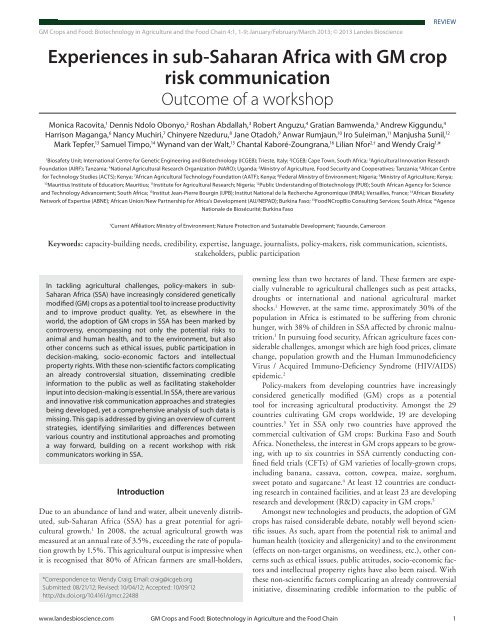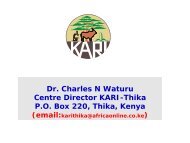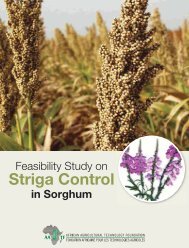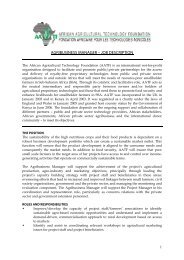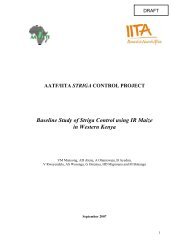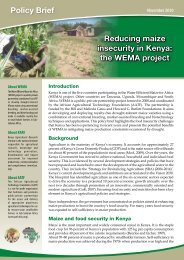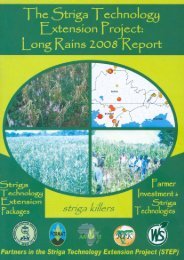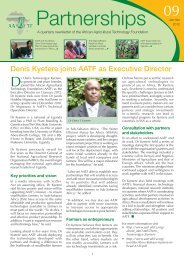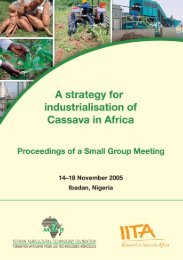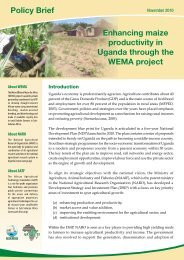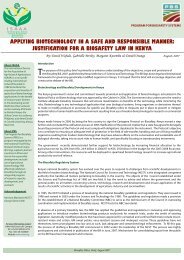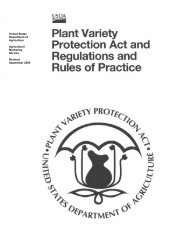Experiences in sub-Saharan Africa with GM crop risk communication
Experiences in sub-Saharan Africa with GM crop risk communication
Experiences in sub-Saharan Africa with GM crop risk communication
Create successful ePaper yourself
Turn your PDF publications into a flip-book with our unique Google optimized e-Paper software.
eview<br />
<strong>GM</strong> Crops and Food: Biotechnology <strong>in</strong> Agriculture and the Food Cha<strong>in</strong> 4:1, 1-9; January/February/March 2013; © 2013 Landes Bioscience<br />
REVIEW<br />
<strong>Experiences</strong> <strong>in</strong> <strong>sub</strong>-<strong>Saharan</strong> <strong>Africa</strong> <strong>with</strong> <strong>GM</strong> <strong>crop</strong><br />
<strong>risk</strong> <strong>communication</strong><br />
Outcome of a workshop<br />
Monica Racovita, 1 Dennis Ndolo Obonyo, 2 Roshan Abdallah, 3 Robert Anguzu, 4 Gratian Bamwenda, 5 Andrew Kiggundu, 4<br />
Harrison Maganga, 6 Nancy Muchiri, 7 Ch<strong>in</strong>yere Nzeduru, 8 Jane Otadoh, 9 Anwar Rumjaun, 10 Iro Suleiman, 11 Manjusha Sunil, 12<br />
Mark Tepfer, 13 Samuel Timpo, 14 Wynand van der Walt, 15 Chantal Kaboré-Zoungrana, 16 Lilian Nfor 2,† and Wendy Craig 1, *<br />
1<br />
Biosafety Unit; International Centre for Genetic Eng<strong>in</strong>eer<strong>in</strong>g and Biotechnology (ICGEB); Trieste, Italy; 2 ICGEB; Cape Town, South <strong>Africa</strong>; 3 Agricultural Innovation Research<br />
Foundation (AIRF); Tanzania; 4 National Agricultural Research Organization (NARO); Uganda; 5 M<strong>in</strong>istry of Agriculture, Food Security and Cooperatives; Tanzania; 6 <strong>Africa</strong>n Centre<br />
for Technology Studies (ACTS); Kenya; 7 <strong>Africa</strong>n Agricultural Technology Foundation (AATF); Kenya; 8 Federal M<strong>in</strong>istry of Environment; Nigeria; 9 M<strong>in</strong>istry of Agriculture; Kenya;<br />
10<br />
Mauritius Institute of Education; Mauritius; 11 Institute for Agricultural Research; Nigeria; 12 Public Understand<strong>in</strong>g of Biotechnology (PUB); South <strong>Africa</strong>n Agency for Science<br />
and Technology Advancement; South <strong>Africa</strong>; 13 Institut Jean-Pierre Bourg<strong>in</strong> (IJPB); Institut National de la Recherche Agronomique (INRA); Versailles, France; 14 <strong>Africa</strong>n Biosafety<br />
Network of Expertise (ABNE); <strong>Africa</strong>n Union/New Partnership for <strong>Africa</strong>’s Development (AU/NEPAD); Burk<strong>in</strong>a Faso; 15 FoodNCropBio Consult<strong>in</strong>g Services; South <strong>Africa</strong>; 16 Agence<br />
Nationale de Biosécurité; Burk<strong>in</strong>a Faso<br />
†<br />
Current Affiliation: M<strong>in</strong>istry of Environment; Nature Protection and Susta<strong>in</strong>able Development; Yaounde, Cameroon<br />
Keywords: capacity-build<strong>in</strong>g needs, credibility, expertise, language, journalists, policy-makers, <strong>risk</strong> <strong>communication</strong>, scientists,<br />
stakeholders, public participation<br />
In tackl<strong>in</strong>g agricultural challenges, policy-makers <strong>in</strong> <strong>sub</strong>-<br />
<strong>Saharan</strong> <strong>Africa</strong> (SSA) have <strong>in</strong>creas<strong>in</strong>gly considered genetically<br />
modified (<strong>GM</strong>) <strong>crop</strong>s as a potential tool to <strong>in</strong>crease productivity<br />
and to improve product quality. Yet, as elsewhere <strong>in</strong> the<br />
world, the adoption of <strong>GM</strong> <strong>crop</strong>s <strong>in</strong> SSA has been marked by<br />
controversy, encompass<strong>in</strong>g not only the potential <strong>risk</strong>s to<br />
animal and human health, and to the environment, but also<br />
other concerns such as ethical issues, public participation <strong>in</strong><br />
decision-mak<strong>in</strong>g, socio-economic factors and <strong>in</strong>tellectual<br />
property rights. With these non-scientific factors complicat<strong>in</strong>g<br />
an already controversial situation, dissem<strong>in</strong>at<strong>in</strong>g credible<br />
<strong>in</strong>formation to the public as well as facilitat<strong>in</strong>g stakeholder<br />
<strong>in</strong>put <strong>in</strong>to decision-mak<strong>in</strong>g is essential. In SSA, there are various<br />
and <strong>in</strong>novative <strong>risk</strong> <strong>communication</strong> approaches and strategies<br />
be<strong>in</strong>g developed, yet a comprehensive analysis of such data is<br />
miss<strong>in</strong>g. This gap is addressed by giv<strong>in</strong>g an overview of current<br />
strategies, identify<strong>in</strong>g similarities and differences between<br />
various country and <strong>in</strong>stitutional approaches and promot<strong>in</strong>g<br />
a way forward, build<strong>in</strong>g on a recent workshop <strong>with</strong> <strong>risk</strong><br />
communicators work<strong>in</strong>g <strong>in</strong> SSA.<br />
Introduction<br />
Due to an abundance of land and water, albeit unevenly distributed,<br />
<strong>sub</strong>-<strong>Saharan</strong> <strong>Africa</strong> (SSA) has a great potential for agricultural<br />
growth. 1 In 2008, the actual agricultural growth was<br />
measured at an annual rate of 3.5%, exceed<strong>in</strong>g the rate of population<br />
growth by 1.5%. This agricultural output is impressive when<br />
it is recognised that 80% of <strong>Africa</strong>n farmers are small-holders,<br />
*Correspondence to: Wendy Craig; Email: craig@icgeb.org<br />
Submitted: 08/21/12; Revised: 10/04/12; Accepted: 10/09/12<br />
http://dx.doi.org/10.4161/gmcr.22488<br />
own<strong>in</strong>g less than two hectares of land. These farmers are especially<br />
vulnerable to agricultural challenges such as pest attacks,<br />
droughts or <strong>in</strong>ternational and national agricultural market<br />
shocks. 1 However, at the same time, approximately 30% of the<br />
population <strong>in</strong> <strong>Africa</strong> is estimated to be suffer<strong>in</strong>g from chronic<br />
hunger, <strong>with</strong> 38% of children <strong>in</strong> SSA affected by chronic malnutrition.<br />
1 In pursu<strong>in</strong>g food security, <strong>Africa</strong>n agriculture faces considerable<br />
challenges, amongst which are high food prices, climate<br />
change, population growth and the Human Immunodeficiency<br />
Virus / Acquired Immuno-Deficiency Syndrome (HIV/AIDS)<br />
epidemic. 2<br />
Policy-makers from develop<strong>in</strong>g countries have <strong>in</strong>creas<strong>in</strong>gly<br />
considered genetically modified (<strong>GM</strong>) <strong>crop</strong>s as a potential<br />
tool for <strong>in</strong>creas<strong>in</strong>g agricultural productivity. Amongst the 29<br />
countries cultivat<strong>in</strong>g <strong>GM</strong> <strong>crop</strong>s worldwide, 19 are develop<strong>in</strong>g<br />
countries. 3 Yet <strong>in</strong> SSA only two countries have approved the<br />
commercial cultivation of <strong>GM</strong> <strong>crop</strong>s: Burk<strong>in</strong>a Faso and South<br />
<strong>Africa</strong>. Nonetheless, the <strong>in</strong>terest <strong>in</strong> <strong>GM</strong> <strong>crop</strong>s appears to be grow<strong>in</strong>g,<br />
<strong>with</strong> up to six countries <strong>in</strong> SSA currently conduct<strong>in</strong>g conf<strong>in</strong>ed<br />
field trials (CFTs) of <strong>GM</strong> varieties of locally-grown <strong>crop</strong>s,<br />
<strong>in</strong>clud<strong>in</strong>g banana, cassava, cotton, cowpea, maize, sorghum,<br />
sweet potato and sugarcane. 4 At least 12 countries are conduct<strong>in</strong>g<br />
research <strong>in</strong> conta<strong>in</strong>ed facilities, and at least 23 are develop<strong>in</strong>g<br />
research and development (R&D) capacity <strong>in</strong> <strong>GM</strong> <strong>crop</strong>s. 5<br />
Amongst new technologies and products, the adoption of <strong>GM</strong><br />
<strong>crop</strong>s has raised considerable debate, notably well beyond scientific<br />
issues. As such, apart from the potential <strong>risk</strong> to animal and<br />
human health (toxicity and allergenicity) and to the environment<br />
(effects on non-target organisms, on weed<strong>in</strong>ess, etc.), other concerns<br />
such as ethical issues, public attitudes, socio-economic factors<br />
and <strong>in</strong>tellectual property rights have also been raised. With<br />
these non-scientific factors complicat<strong>in</strong>g an already controversial<br />
<strong>in</strong>itiative, dissem<strong>in</strong>at<strong>in</strong>g credible <strong>in</strong>formation to the public of<br />
www.landesbioscience.com <strong>GM</strong> Crops and Food: Biotechnology <strong>in</strong> Agriculture and the Food Cha<strong>in</strong> 1
the <strong>risk</strong>s and benefits of <strong>GM</strong> <strong>crop</strong>s, as well as facilitat<strong>in</strong>g their<br />
<strong>in</strong>put <strong>in</strong>to decision-mak<strong>in</strong>g, is essential. The public acceptance<br />
of <strong>GM</strong> <strong>crop</strong>s <strong>in</strong> countries of SSA is divided, but generally, the<br />
more familiar the public is <strong>with</strong> biotechnology, the more they<br />
tend to hold a positive view. 6-14 Even when concerns of <strong>risk</strong>s<br />
abound, there is great <strong>in</strong>terest <strong>in</strong> the prospects that biotechnology<br />
can br<strong>in</strong>g towards food security, agriculture improvement<br />
and economic ga<strong>in</strong>s, and also a great <strong>in</strong>terest <strong>in</strong> obta<strong>in</strong><strong>in</strong>g more<br />
<strong>in</strong>formation on the <strong>sub</strong>ject. 6,8,12,14 Yet <strong>communication</strong> concern<strong>in</strong>g<br />
the potential <strong>risk</strong>s and benefits of <strong>GM</strong> <strong>crop</strong>s has been perceived<br />
by various stakeholders <strong>in</strong> SSA as generally poor, and one<br />
of the ma<strong>in</strong> factors lead<strong>in</strong>g to the delay <strong>in</strong> approval for <strong>GM</strong> <strong>crop</strong>s<br />
throughout the <strong>sub</strong>-cont<strong>in</strong>ent. 15<br />
Along <strong>with</strong> <strong>risk</strong> assessment and <strong>risk</strong> management, <strong>risk</strong> <strong>communication</strong><br />
is one of the major components of <strong>risk</strong> analysis and<br />
represents the “exchange of <strong>in</strong>formation and op<strong>in</strong>ions concern<strong>in</strong>g<br />
<strong>risk</strong> and <strong>risk</strong>-related factors among various stakeholders concerned<br />
<strong>with</strong> <strong>risk</strong>.” 16 This view of <strong>risk</strong> <strong>communication</strong> as a two-way<br />
process represents a departure from the former, and <strong>in</strong> some ways<br />
arrogant, one-way transfer of <strong>in</strong>formation from “experts” toward<br />
an “uneducated” and hence easily-deceived public. 17 The role of<br />
<strong>risk</strong> <strong>communication</strong> should be to provide timely <strong>in</strong>formation<br />
and to improve <strong>communication</strong> amongst stakeholders, towards<br />
the enabl<strong>in</strong>g of decisions <strong>with</strong> a wider acceptance, prevent<strong>in</strong>g<br />
crises, assur<strong>in</strong>g a greater implementation of resolutions, <strong>in</strong>volv<strong>in</strong>g<br />
the public <strong>in</strong> decision-mak<strong>in</strong>gs and build<strong>in</strong>g trust. 18 For successful<br />
<strong>risk</strong> <strong>communication</strong>, several guid<strong>in</strong>g pr<strong>in</strong>ciples have been<br />
proposed: know your audience, <strong>in</strong>volve scientific experts, establish<br />
expertise <strong>in</strong> <strong>communication</strong>, be a credible source of <strong>in</strong>formation,<br />
share responsibility amongst <strong>risk</strong> assessors for the outcome<br />
of the <strong>risk</strong> analysis process, differentiate between science and<br />
value judgements, assume transparency and place the <strong>risk</strong> <strong>in</strong><br />
context. 19 Further, identified barriers to effective <strong>risk</strong> <strong>communication</strong><br />
are typically <strong>in</strong>stitutional and procedural <strong>in</strong> nature (such<br />
as access to <strong>in</strong>formation and participation <strong>in</strong> the process) when<br />
consider<strong>in</strong>g the decision-mak<strong>in</strong>g process, whilst regard<strong>in</strong>g <strong>communication</strong><br />
as a whole, differences <strong>in</strong> audience perceptions and<br />
receptivity, the lack of understand<strong>in</strong>g of the scientific process,<br />
the credibility of the <strong>in</strong>formation source and communicator, the<br />
role of the media and societal characteristics all become equally<br />
prom<strong>in</strong>ent. 19 Furthermore, as examples brought by <strong>risk</strong> communicators<br />
<strong>in</strong> SSA will illustrate, the very choice of words for the<br />
concepts employed can prove to be contentious. As such, “<strong>risk</strong><br />
<strong>communication</strong>” can po<strong>in</strong>t towards a fear-<strong>in</strong>duc<strong>in</strong>g <strong>sub</strong>ject <strong>with</strong><br />
an emphasis on <strong>risk</strong>, <strong>in</strong>stead of a more balanced “<strong>risk</strong>-benefit<br />
<strong>communication</strong>.”<br />
In SSA, <strong>in</strong>formation about the various <strong>in</strong>novative <strong>risk</strong> <strong>communication</strong><br />
approaches and strategies be<strong>in</strong>g used is available <strong>in</strong><br />
isolated locations, and opportunities for <strong>risk</strong> communicators to<br />
learn from one another are scarce. This paper aims to address<br />
this gap, to provide an overview of current strategies, identify<strong>in</strong>g<br />
similarities and differences between country and <strong>in</strong>stitutional<br />
experiences (summarized <strong>in</strong> Table 1), as well as promot<strong>in</strong>g a way<br />
forward for <strong>risk</strong> <strong>communication</strong> <strong>in</strong> SSA, build<strong>in</strong>g on previously<br />
published evidence, and the <strong>in</strong>formation and experiences generated<br />
from the Biosafety Risk Communication <strong>in</strong> <strong>sub</strong>-<strong>Saharan</strong><br />
<strong>Africa</strong> workshop organized by the ICGEB <strong>in</strong> collaboration<br />
<strong>with</strong> the University of Mauritius and the Food and Agricultural<br />
Research Council, June 8–10, 2011, <strong>in</strong> Quatre-Bornes, Mauritius.<br />
Risk Communication Strategies<br />
Participation of stakeholders <strong>in</strong> decision-mak<strong>in</strong>g and awareness-rais<strong>in</strong>g.<br />
Stakeholder participation <strong>in</strong> decision-mak<strong>in</strong>g is a<br />
requirement of <strong>in</strong>ternational treaties concern<strong>in</strong>g the governance<br />
of biotechnology such as the Cartagena Protocol on Biosafety<br />
(CPB), 20 and it is beg<strong>in</strong>n<strong>in</strong>g to be viewed more positively for publicly-funded<br />
biotechnology research. 21 It is notable that for many<br />
develop<strong>in</strong>g countries, implement<strong>in</strong>g the CPB has been their first<br />
experience <strong>in</strong> participatory policy-mak<strong>in</strong>g. 22 The justification for<br />
stakeholder participation varies, <strong>in</strong>clud<strong>in</strong>g the right of people to<br />
overview the spend<strong>in</strong>g of tax revenue, the potential to prevent<br />
conflicts between parties overtly for and aga<strong>in</strong>st Genetically<br />
Modified Organisms (<strong>GM</strong>Os), the possibility to ga<strong>in</strong> early <strong>in</strong>put<br />
from consumers and to contribute to better product development.<br />
23-25 Although such participation may <strong>in</strong>crease the cost of<br />
decision-mak<strong>in</strong>g, it has been argued that it can actually speed up<br />
the process and legitimize it, thus reduc<strong>in</strong>g enforcement costs. 24<br />
It has also been reported that the public is more likely to accept<br />
a decision if it has been taken <strong>with</strong> wider stakeholder <strong>in</strong>clusion. 23<br />
With<strong>in</strong> SSA, the ma<strong>in</strong> governmental agency <strong>in</strong> Burk<strong>in</strong>a Faso<br />
responsible for the authorization of <strong>GM</strong>Os, l’Agence Nationale<br />
de Biosécurité, has provisions for <strong>in</strong>volv<strong>in</strong>g the public <strong>in</strong> decisionmak<strong>in</strong>g,<br />
and it attributed the success of its <strong>in</strong>sect resistant (Bt)<br />
cotton <strong>risk</strong> <strong>communication</strong> strategies <strong>in</strong> part to the <strong>in</strong>volvement<br />
of varied stakeholders early <strong>in</strong> the adoption of the biosafety law, <strong>in</strong><br />
the awareness-rais<strong>in</strong>g campaigns and <strong>in</strong> undertak<strong>in</strong>g the CFTs.<br />
Tanzania and Ghana also promote stakeholder <strong>in</strong>volvement <strong>in</strong><br />
their current <strong>risk</strong> <strong>communication</strong> approaches. In Tanzania,<br />
<strong>risk</strong> <strong>communication</strong> messages were delivered more efficiently if<br />
designed <strong>in</strong> collaboration <strong>with</strong> community representatives and<br />
even delivered by them <strong>in</strong> the local language. In Eastern <strong>Africa</strong>,<br />
public awareness of <strong>GM</strong> <strong>crop</strong>s is generally low, <strong>with</strong> programs <strong>in</strong>itially<br />
designed to address it currently suspended for lack of funds.<br />
Public participation <strong>in</strong> decision-mak<strong>in</strong>g rema<strong>in</strong>s weak, although<br />
there have been improvements <strong>in</strong> recent years. 22 Throughout SSA,<br />
the major challenges <strong>in</strong> the participation of relevant stakeholders<br />
<strong>in</strong> awareness-rais<strong>in</strong>g <strong>in</strong>clude (1) the low engagement of scientists<br />
and the <strong>in</strong>itial <strong>in</strong>difference of the general public, especially <strong>in</strong><br />
South <strong>Africa</strong>, (2) journalistic “fatigue” as <strong>in</strong> Kenya, where journalists<br />
have become weary of cover<strong>in</strong>g biotechnology and related<br />
stories <strong>in</strong> the absence of either new advancements or controversies<br />
and (3) the low level of literacy and access to <strong>in</strong>formation tools,<br />
exemplified <strong>in</strong> Tanzania.<br />
Tailor<strong>in</strong>g strategies to specific stakeholders groups. Messages<br />
have been shown to be more effective when based on <strong>communication</strong><br />
strategies developed for specific stakeholder groups and<br />
tailored to their experiences and attitudes. The ma<strong>in</strong> stakeholder<br />
groups usually targeted <strong>in</strong> SSA are policy-makers and politicians,<br />
journalists, scientists, farmers, op<strong>in</strong>ion leaders and students. For<br />
policy-makers and politicians <strong>in</strong> Burk<strong>in</strong>a Faso, short messages<br />
were developed describ<strong>in</strong>g the benefits and <strong>risk</strong>s of <strong>GM</strong> <strong>crop</strong>s<br />
2 <strong>GM</strong> Crops and Food: Biotechnology <strong>in</strong> Agriculture and the Food Cha<strong>in</strong> Volume 4 Issue 1
Table 1. Risk <strong>communication</strong> strategies <strong>in</strong> <strong>sub</strong>-<strong>Saharan</strong> <strong>Africa</strong>: successes and challenges<br />
Country Lessons learned/ What worked Challenges<br />
Burk<strong>in</strong>a Faso<br />
Ghana<br />
Kenya<br />
Mauritius<br />
Nigeria<br />
Involvement of cotton producers and corporate sector <strong>in</strong> the field<br />
trials and Bt cotton adoption; <strong>in</strong>volvement of all the stakeholders<br />
<strong>in</strong> Biotechnology and Biosafety dur<strong>in</strong>g the adoption of the<br />
law and its revision; <strong>in</strong>volvement of the policy-makers dur<strong>in</strong>g the<br />
awareness-rais<strong>in</strong>g campaigns.<br />
Us<strong>in</strong>g experts creates credibility; <strong>communication</strong> specialists <strong>in</strong><br />
meet<strong>in</strong>g <strong>with</strong> the media.<br />
Develop<strong>in</strong>g skills, such as rema<strong>in</strong><strong>in</strong>g calm and collected, and be<strong>in</strong>g<br />
able to reply to difficult questions by another question; constant<br />
dialogue among stakeholders.<br />
One-on-one strategy for key persons <strong>in</strong> positions of <strong>in</strong>fluence.<br />
Delegations from a pool of resource person periodically sent to<br />
M<strong>in</strong>isters; requests to M<strong>in</strong>isters accompanied by briefs; avoid<strong>in</strong>g<br />
unwarranted bureaucratic set-up <strong>in</strong> <strong>in</strong>formation dissem<strong>in</strong>ation.<br />
Use of agricultural <strong>in</strong>formation centres, radio, TV, <strong>in</strong>formation vans,<br />
emails and SMS text<strong>in</strong>g as <strong>communication</strong> media.<br />
Appreciat<strong>in</strong>g the importance of “non-science” constituencies;<br />
keep<strong>in</strong>g records of proceed<strong>in</strong>gs; Standardis<strong>in</strong>g messages to avoid<br />
possible contradictions; use of professional communicators.<br />
Interaction between scientists and the media has made it possible<br />
for scientists to be able to differentiate between media <strong>in</strong>struments<br />
and when to use TV, radio, pr<strong>in</strong>t media, social media and<br />
onl<strong>in</strong>e publications for different k<strong>in</strong>ds of <strong>in</strong>formation. There are<br />
now specialized publications for science <strong>communication</strong> <strong>in</strong> Kenya.<br />
Consultancy team members were of varied expertise.<br />
High level of <strong>in</strong>teraction of participants (though small <strong>in</strong> number)<br />
was noted <strong>in</strong> workshop.<br />
Participants <strong>in</strong> workshop were able to develop their knowledge<br />
and understand<strong>in</strong>g of the issues.<br />
Until commercialization, it was perceived that cotton producers<br />
were the ma<strong>in</strong> target groups of the <strong>communication</strong> process,<br />
to the detriment of other groups.<br />
Not a lot of <strong>in</strong>formation made available through wider dissem<strong>in</strong>ation<br />
tools (websites).<br />
Low educational level of many of the recipients.<br />
Insufficient use of champions.<br />
Misconceptions; <strong>in</strong>appropriate term<strong>in</strong>ology; poor <strong>communication</strong><br />
between and among stakeholders; packag<strong>in</strong>g the message;<br />
low budgetary and <strong>in</strong>stitutional support; non-science<br />
group values; role separation; embellishment of <strong>in</strong>formation<br />
for political purposes and media ga<strong>in</strong>s; need to adapt materials<br />
to context; keep<strong>in</strong>g up <strong>with</strong> activists.<br />
There were no <strong>in</strong>centives for journalists to cover biotechnology<br />
stories, s<strong>in</strong>ce there is no official cultivation of <strong>GM</strong> <strong>crop</strong>s<br />
<strong>in</strong> Kenya;<br />
Journalistic “fatigue” (always the same stories about biotechnology);<br />
Lack of science writers;<br />
High turnover of journalists.<br />
Lack of valid data to support claims made about <strong>GM</strong>O <strong>risk</strong>s;<br />
Differ<strong>in</strong>g perceptions amongst <strong>risk</strong> managers about what is<br />
important to communicate;<br />
The use of jargon that results <strong>in</strong> the provision of confus<strong>in</strong>g<br />
and distorted <strong>in</strong>formation.<br />
Jurisdictional disputes that <strong>in</strong>hibit <strong>in</strong>formation gather<strong>in</strong>g<br />
and dissem<strong>in</strong>ation efforts; the cont<strong>in</strong>ually chang<strong>in</strong>g political<br />
climate;<br />
Questionable credibility of the message and/or messenger;<br />
non-disclosure of <strong>risk</strong>-related <strong>in</strong>formation due to bus<strong>in</strong>ess<br />
confidentiality and legal considerations<br />
Information not provided <strong>in</strong> a timely manner;<br />
Limited access to <strong>communication</strong> technology and/or lack of<br />
technology <strong>in</strong>tegration;<br />
Lack of <strong>in</strong>centives to perform long-term <strong>risk</strong> plann<strong>in</strong>g studies.<br />
Major constra<strong>in</strong>t <strong>in</strong> the participation of ma<strong>in</strong> stakeholders was<br />
the large absence of representatives from media, and policy<br />
makers;<br />
Some participants misunderstood of the aim of the workshop-misconception<br />
(2009 workshop);<br />
Not enough time to <strong>in</strong>ternalize the message;<br />
Low participation.<br />
Lack of proper public understand<strong>in</strong>g of biotechnology concepts<br />
and activities;<br />
Poor knowledge and limited access to scientists, media and<br />
the public;<br />
Limited knowledge and capacity of <strong>risk</strong> <strong>communication</strong> processes<br />
and procedures of regulatory authorities;<br />
Inadequate funds for the implementation of annual work<br />
plans of organisations that may take the lead <strong>in</strong> <strong>communication</strong><br />
issues.<br />
A summary of <strong>in</strong>formation presented dur<strong>in</strong>g the workshop<br />
www.landesbioscience.com <strong>GM</strong> Crops and Food: Biotechnology <strong>in</strong> Agriculture and the Food Cha<strong>in</strong> 3
Table 1. Risk <strong>communication</strong> strategies <strong>in</strong> <strong>sub</strong>-<strong>Saharan</strong> <strong>Africa</strong>: successes and challenges<br />
South <strong>Africa</strong><br />
Tanzania<br />
Uganda<br />
<strong>Africa</strong>n<br />
Agricultural<br />
Technology<br />
Foundation<br />
(AATF)<br />
Agricultural magaz<strong>in</strong>es to br<strong>in</strong>g <strong>in</strong>formation to producers, farmers,<br />
regulators contribut<strong>in</strong>g to the approval of <strong>GM</strong> seeds.<br />
Understand<strong>in</strong>g the social environment and landscape, and hav<strong>in</strong>g<br />
an engagement strategy <strong>with</strong> the relevant stakeholders.<br />
Involvement of farmer communities who, based on their <strong>in</strong>digenous<br />
knowledge systems, are more likely to trust their own, and<br />
<strong>in</strong> their language.<br />
Design<strong>in</strong>g <strong>communication</strong> messages <strong>in</strong> collaboration <strong>with</strong> community<br />
representatives.<br />
L<strong>in</strong>kage to exist<strong>in</strong>g value and supply cha<strong>in</strong>s; Rural farm communities<br />
are sensitive and cautious to change <strong>in</strong>itiated from outside the<br />
community.<br />
Information transmitted by traditional elders posters, village<br />
notice board, launches and trade fairs.<br />
Project specific Questions and Answers (Q&As).<br />
Understand<strong>in</strong>g the function of <strong>in</strong>stitutions <strong>with</strong> whom to communicate<br />
e.g. different <strong>communication</strong> strategies may be required for<br />
different groups.<br />
Limit <strong>communication</strong> at the early stages of <strong>GM</strong>O development <strong>in</strong><br />
order not to raise expectations unnecessarily and to prevent “biosafety<br />
fatigue”.<br />
Design messages to clearly designate research from products.<br />
Use national relevance as much as possible.<br />
Spread the <strong>communication</strong> across sectors, e.g., health and pharmaceuticals,<br />
environment and <strong>in</strong>dustry.<br />
Reputation is key. Individuals/organizations <strong>in</strong>volved <strong>in</strong> <strong>communication</strong><br />
should do so from a position of trust.<br />
Effective <strong>communication</strong> is a two-way process.<br />
Accurate and consistent messag<strong>in</strong>g is vital.<br />
Teamwork is critical for success.<br />
It is useful to communicate <strong>in</strong> local languages.<br />
Advocacy should be used where needed.<br />
Outreach should be timed to project progress and developments.<br />
There should also be accountability.<br />
Consultation and early on-board<strong>in</strong>g helps <strong>with</strong> buy-<strong>in</strong>.<br />
Use of experts.<br />
OFAB-facilitated meet<strong>in</strong>gs between member states; Increased<br />
awareness closed gaps between scientists and journalists.<br />
A large percentage of the population have no knowledge/<br />
<strong>in</strong>different on the <strong>sub</strong>ject;<br />
Low levels of education/literacy;<br />
11 official languages;<br />
Communication on issues by experts;<br />
A <strong>communication</strong> gap between key players;<br />
Lack of <strong>in</strong>stant reactions from communicators;<br />
Lack of personal relationships <strong>with</strong> journalists;<br />
Scientists engagement <strong>in</strong> <strong>communication</strong> is low.<br />
Low level of literacy and/or understand<strong>in</strong>g of the proposed<br />
biotechnology <strong>in</strong>terventions.<br />
Low level of <strong>in</strong>terest.<br />
Perception problem; potential for mis<strong>in</strong>terpretation.<br />
Resistance to chang<strong>in</strong>g to a new paradigm.<br />
Majority of the population live <strong>in</strong> rural sett<strong>in</strong>gs, lack<strong>in</strong>g electricity<br />
and access to sources of <strong>in</strong>formation.<br />
Ineffective <strong>communication</strong> channels: audio-visual-based<br />
<strong>communication</strong>s, especially radio, TV, newspapers, websites,<br />
<strong>in</strong>ternet campaigns, newsletter and advertorials, publications<br />
<strong>in</strong> scientific journals, booklets and books.<br />
A summary of <strong>in</strong>formation presented dur<strong>in</strong>g the workshop<br />
and supplemented <strong>with</strong> cultivation data and field visits. S<strong>in</strong>ce<br />
researchers and academics enjoyed a higher public trust than policy-makers,<br />
the tailored <strong>communication</strong> strategies also assisted <strong>in</strong><br />
transform<strong>in</strong>g the recipients <strong>in</strong>to biosafety communicators themselves.<br />
To this end, scientists and academics <strong>in</strong> Burk<strong>in</strong>a Faso and<br />
Ghana benefited from participat<strong>in</strong>g <strong>in</strong> multiple biotechnology<br />
and biosafety tra<strong>in</strong><strong>in</strong>gs, workshops and regional and <strong>in</strong>ternational<br />
discussion fora. In other sett<strong>in</strong>gs, scientists are usually the<br />
stakeholder group <strong>with</strong> the highest level of awareness concern<strong>in</strong>g<br />
biotechnology. For example, they are very good at acquir<strong>in</strong>g any<br />
<strong>in</strong>formation they need, usually through scientific journals, the<br />
<strong>in</strong>ternet, periodicals, and <strong>in</strong> discussions <strong>with</strong> colleagues, all usually<br />
<strong>with</strong>out active efforts from <strong>risk</strong> <strong>communication</strong> specialists,<br />
as shown <strong>in</strong> Nigeria. 6 Journalists, on the other hand, who are<br />
often highly trusted by the public, rely on develop<strong>in</strong>g personal<br />
connections and upon tra<strong>in</strong><strong>in</strong>g <strong>in</strong> scientific writ<strong>in</strong>g to replace scientific<br />
jargon <strong>with</strong> more familiar term<strong>in</strong>ology (discussed below).<br />
Op<strong>in</strong>ion leaders benefit from more targeted strategies <strong>in</strong>volv<strong>in</strong>g<br />
one-on-one <strong>communication</strong>, as seen <strong>in</strong> Ghana. For students,<br />
emphasis is placed on strategies such as the <strong>in</strong>clusion of material<br />
on biotechnology <strong>in</strong> curricula, discussions <strong>with</strong> experts, and<br />
<strong>in</strong>teractive theatre performances (such as <strong>in</strong> Burk<strong>in</strong>a Faso and<br />
South <strong>Africa</strong>). For farmers, materials <strong>in</strong> a number of formats such<br />
as audio, text, and cartoons were translated <strong>in</strong>to vernacular languages,<br />
and public discussions were held to clarify issues, as <strong>in</strong><br />
Burk<strong>in</strong>a Faso.<br />
4 <strong>GM</strong> Crops and Food: Biotechnology <strong>in</strong> Agriculture and the Food Cha<strong>in</strong> Volume 4 Issue 1
Table 2. Communication <strong>in</strong>dicators <strong>in</strong> SSA<br />
Country<br />
Daily newspapers per 1,000 people 2000-07 (for a<br />
Percentage of households <strong>with</strong> (for a review see ref. 38)<br />
review see ref. 37)<br />
Radio 2007 TV 2007 PC 2007 Internet access at home 2007<br />
Burk<strong>in</strong>a Faso - 69.5 16.9 1.6 -<br />
Ghana - - 38.8 5.1 0.3<br />
Kenya - - - 5.5 2.2<br />
Mauritius 77 - 96.4 a 30 a 20.2 a<br />
Nigeria - 72.4 a 39.3 a 12 a 6 a<br />
South <strong>Africa</strong> 30 - 71.6 b - 8.8 b<br />
Tanzania 2 58.4 7.8 - 0.6<br />
Uganda - - - - -<br />
a<br />
data from 2008; b data from 2009.<br />
Employ<strong>in</strong>g and tra<strong>in</strong><strong>in</strong>g <strong>communication</strong> specialists. A<br />
shortage of biosafety <strong>communication</strong> specialists is acutely felt <strong>in</strong><br />
SSA. Most tra<strong>in</strong><strong>in</strong>g activities are be<strong>in</strong>g targeted towards scientists<br />
and journalists. These two groups have been identified as<br />
key to the <strong>risk</strong> <strong>communication</strong> process <strong>in</strong> Kenya, however they<br />
must overcome quite different difficulties <strong>in</strong> tra<strong>in</strong><strong>in</strong>g to become<br />
<strong>communication</strong> specialists: scientists are often unable to present<br />
their scientific knowledge <strong>in</strong> terms commonly used by laypeople,<br />
whilst journalists often create misrepresentations or alarm<strong>in</strong>g<br />
accounts <strong>in</strong> their pursuit of sensationalism. 26,27 Fill<strong>in</strong>g a <strong>communication</strong><br />
gap between the two groups is the goal of several<br />
current tra<strong>in</strong><strong>in</strong>g programmes. In South <strong>Africa</strong>, a media roundtable<br />
<strong>in</strong>itiative called “W<strong>in</strong>e and <strong>GM</strong>Os” brought scientists and<br />
journalists together, enabl<strong>in</strong>g the latter to acquire a better understand<strong>in</strong>g<br />
of the science and extra-scientific issues concern<strong>in</strong>g<br />
<strong>GM</strong>Os. Efforts <strong>in</strong> Egypt, Kenya, Nigeria, Tanzania and Uganda<br />
<strong>with</strong> similar objectives are be<strong>in</strong>g carried out through the Open<br />
Forum for Agricultural Biotechnology (OFAB; www.ofabafrica.<br />
org), a regional <strong>in</strong>itiative for public engagement, while <strong>in</strong> South<br />
<strong>Africa</strong> <strong>Africa</strong>Bio has conducted regular workshops for tra<strong>in</strong><strong>in</strong>g<br />
communicators. These efforts have raised levels of awareness, and<br />
are help<strong>in</strong>g to close <strong>communication</strong> gaps between scientists and<br />
journalists. The cultivation of personal connections between scientists<br />
and journalists helps further reduce their <strong>communication</strong><br />
gap, yet develop<strong>in</strong>g such relationships can be h<strong>in</strong>dered by the<br />
high turnover of journalists. 28<br />
In Burk<strong>in</strong>a Faso, <strong>risk</strong> communicators employed to <strong>in</strong>teract<br />
<strong>with</strong> the media have learned <strong>with</strong> experience to rema<strong>in</strong> calm and<br />
collected when answer<strong>in</strong>g, even for those questions show<strong>in</strong>g a<br />
lack of understand<strong>in</strong>g of the issue, and to ma<strong>in</strong>ta<strong>in</strong> the course<br />
of the discussion <strong>with</strong><strong>in</strong> the boundaries of scientific evidence. In<br />
Kenya, the communicators quickly learned to match the appropriate<br />
language to the media types selected to disperse the message;<br />
thus, different approaches were used for <strong>communication</strong>s<br />
via TV, radio, pr<strong>in</strong>t or social media.<br />
The credibility of the tra<strong>in</strong>ed <strong>risk</strong> communicators was of<br />
high priority and essential to successful message transmission.<br />
In Burk<strong>in</strong>a Faso for example, the use of experts to convey specific<br />
messages known to be <strong>with</strong><strong>in</strong> their recognised area of competence<br />
gave the message credibility <strong>in</strong> the eyes of the public.<br />
In Ghana, scientists were encouraged to replace policy-makers<br />
as active communicators, as the latter were perceived as lack<strong>in</strong>g<br />
<strong>in</strong> credibility. However, where government sources are highly<br />
trusted, they can contribute <strong>sub</strong>stantially to a positive perception<br />
of biotechnology, especially when work<strong>in</strong>g together <strong>with</strong> specialised<br />
science writers to deliver a well-<strong>in</strong>formed media coverage. 28<br />
This is echoed by the experience <strong>in</strong> Uganda, where public trust <strong>in</strong><br />
governmental organisations is higher than for scientists and the<br />
private sector, which are viewed <strong>with</strong> suspicion. 10 In Tanzania,<br />
it is the media that is most trusted by the people, yet conflict<strong>in</strong>g<br />
and heavily-biased messages (i.e., either strongly <strong>in</strong> favour or<br />
strongly opposed to <strong>GM</strong> <strong>crop</strong>s) are transmitted, as the reporters<br />
usually have little or no scientific background. 29<br />
Employ<strong>in</strong>g various <strong>communication</strong> tools. In SSA, the recognition<br />
of the necessity to have a two-way <strong>communication</strong> process<br />
came <strong>with</strong> the acknowledgement of the limitations <strong>in</strong> the use of<br />
radio as an <strong>in</strong>formation tool for wide dissem<strong>in</strong>ation. Although<br />
radio is the ma<strong>in</strong> <strong>communication</strong> tool available <strong>in</strong> SSA (Table<br />
2), it does present limitations <strong>in</strong> that it is <strong>in</strong>capable of susta<strong>in</strong><strong>in</strong>g<br />
dialogue and thus often perpetuates misunderstand<strong>in</strong>gs. Other<br />
tools <strong>in</strong>clude more traditional sources such as newsletters and<br />
public debates, as well as mobile libraries and <strong>in</strong>teractive theatres,<br />
whilst e-mails, mobile phones and social media are becom<strong>in</strong>g<br />
more prom<strong>in</strong>ent. Although radio is “k<strong>in</strong>g,” it is be<strong>in</strong>g used <strong>in</strong><br />
comb<strong>in</strong>ation <strong>with</strong> other complement<strong>in</strong>g and re<strong>in</strong>forc<strong>in</strong>g tools to<br />
help deliver more effective messages, as presented below.<br />
In Burk<strong>in</strong>a Faso and Kenya, radio is the ma<strong>in</strong> <strong>communication</strong><br />
tool for convey<strong>in</strong>g <strong>in</strong>formation concern<strong>in</strong>g agricultural biotechnology.<br />
30 Yet, while provid<strong>in</strong>g a plethora of <strong>in</strong>formation, only a<br />
limited number of broadcasts <strong>in</strong>volved the <strong>in</strong>put of experts. Still,<br />
radio is a major source of <strong>in</strong>formation on biotechnology for<br />
Kenyans, supplemented by efforts from educational <strong>in</strong>stitutions<br />
and the food <strong>in</strong>dustry. 8<br />
Generally, beyond the wide-reach<strong>in</strong>g media, local efforts <strong>in</strong><br />
<strong>risk</strong> <strong>communication</strong> can be more relevant and better coord<strong>in</strong>ated.<br />
In Burk<strong>in</strong>a Faso for example, <strong>in</strong>formation on biosafety has been<br />
published <strong>in</strong> widely-dissem<strong>in</strong>ated monthly newsletters, broadcast<br />
on radio stations <strong>with</strong> rural coverage, distributed through<br />
motorcycle-based mobile libraries and has been the focus of local<br />
awareness-creation activities. Also, <strong>communication</strong> on a personal<br />
level benefits from greater trust, <strong>with</strong> friends and acqua<strong>in</strong>tances<br />
be<strong>in</strong>g an important source of <strong>in</strong>formation, even the ma<strong>in</strong> source<br />
www.landesbioscience.com <strong>GM</strong> Crops and Food: Biotechnology <strong>in</strong> Agriculture and the Food Cha<strong>in</strong> 5
of <strong>in</strong>formation regard<strong>in</strong>g <strong>GM</strong>Os as reported <strong>in</strong> Ghana and therefore<br />
rema<strong>in</strong>s an opportunity for <strong>in</strong>clusion <strong>in</strong> <strong>risk</strong> <strong>communication</strong><br />
strategies. 9<br />
The success of local <strong>communication</strong> tools <strong>in</strong> dissem<strong>in</strong>at<strong>in</strong>g<br />
<strong>in</strong>formation concern<strong>in</strong>g the <strong>risk</strong>s and benefits of <strong>GM</strong> <strong>crop</strong>s did<br />
not dim<strong>in</strong>ish the importance of wider-reach<strong>in</strong>g <strong>communication</strong><br />
tools. Often, a comb<strong>in</strong>ation of wider reach and local impact <strong>communication</strong><br />
tools can give better results than the use of the two<br />
separately. As such, radio has played a significant role <strong>in</strong> the adoption<br />
of new plant varieties by Nigerian farmers, yet it also presented<br />
limitations by not facilitat<strong>in</strong>g <strong>in</strong>teractions and discussions<br />
between farmers and experts or by alienat<strong>in</strong>g laypeople by not<br />
convers<strong>in</strong>g <strong>in</strong> local languages. 31 In response, workshops can help<br />
dissem<strong>in</strong>ate <strong>in</strong>formation and <strong>in</strong>crease awareness by provid<strong>in</strong>g a<br />
forum <strong>in</strong> which open discussions can take place <strong>with</strong> experts,<br />
thus help<strong>in</strong>g relieve public fears, as <strong>in</strong> Tanzania. 29,32 Key players<br />
<strong>in</strong> dissem<strong>in</strong>at<strong>in</strong>g knowledge <strong>in</strong> this manner are the Nigerian<br />
Agricultural Extension Services and other services of M<strong>in</strong>istries of<br />
Agriculture throughout SSA. 33 With<strong>in</strong> these networks of experts,<br />
agricultural scientists play a major role. A recent survey showed<br />
that the level of awareness amongst these scientists is quite high,<br />
and that they support the commercial approval of <strong>GM</strong> <strong>crop</strong>s <strong>in</strong><br />
Nigeria; their major sources of <strong>in</strong>formation are scientific journals,<br />
the <strong>in</strong>ternet, periodicals and other colleagues. 6<br />
In South <strong>Africa</strong>, radio is not as important a <strong>communication</strong><br />
tool as <strong>in</strong> the rest of the <strong>Africa</strong>n study countries listed <strong>in</strong> Table<br />
2. Risk <strong>communication</strong> strategies generally employ a mixture of<br />
<strong>communication</strong> tools. Use is made of pr<strong>in</strong>ted media, radio and<br />
TV by a range of stakeholders and extends to brochures and presentations<br />
at conferences. The PUB project of the Department of<br />
Science & Technology has employed both playhouse techniques<br />
for school children and students, and full page reviews <strong>in</strong> newspapers.<br />
<strong>Africa</strong>Bio uses farm demonstration trials plus a range of<br />
brochures for local farmers and politicians, as well as for visit<strong>in</strong>g<br />
farmers and politicians from other parts of <strong>Africa</strong>. In addition,<br />
annual media conferences organised by the International Service<br />
for the Acquisition of Agri-biotech Applications (ISAAA) generate<br />
extensive media coverage. Elsewhere, Biosafety South <strong>Africa</strong><br />
issues brochures and secures fund<strong>in</strong>g for projects. Although some<br />
of the f<strong>in</strong>er detail may be lost, as Cooke and Downie argue (for<br />
a review see ref. 34), the ma<strong>in</strong> messages of <strong>risk</strong> <strong>communication</strong><br />
do seem to reach the public as shown by the awareness levels displayed<br />
by farmers and urban populations <strong>in</strong> surveys. 13,14<br />
Although most efforts <strong>in</strong> experience-shar<strong>in</strong>g <strong>with</strong> biotechnology<br />
are reliant upon <strong>in</strong>direct written and verbal channels, the<br />
strategy of “see<strong>in</strong>g-is-believ<strong>in</strong>g” is be<strong>in</strong>g adopted more often for<br />
<strong>risk</strong> <strong>communication</strong> <strong>in</strong> SSA, <strong>with</strong> reports that field trial visits are<br />
becom<strong>in</strong>g a more decisive factor <strong>in</strong> <strong>in</strong>fluenc<strong>in</strong>g farmers to cultivate<br />
<strong>GM</strong> <strong>crop</strong>s. 35 As a result, tours and field trips, field days,<br />
farm walks, exchanges of real life stories <strong>with</strong> farmers already<br />
cultivat<strong>in</strong>g <strong>GM</strong> <strong>crop</strong>s have been employed <strong>in</strong> Nigeria, Tanzania<br />
and Uganda.<br />
Increas<strong>in</strong>gly, recent developments <strong>in</strong> <strong>communication</strong> technology<br />
such as the Internet and mobile phones can be tools of wider<br />
dissem<strong>in</strong>ation and of <strong>in</strong>ter-personal <strong>communication</strong>. With their<br />
<strong>in</strong>creas<strong>in</strong>g availability <strong>in</strong> SSA, the electronic media have quickly<br />
been <strong>in</strong>cluded amongst the tools employed <strong>in</strong> the dissem<strong>in</strong>ation<br />
of <strong>in</strong>formation <strong>in</strong> Ghana, Nigeria and Uganda.<br />
A context-appropriate message. To deliver a message that<br />
will resonate <strong>with</strong> the recipient, two ma<strong>in</strong> factors need consideration:<br />
language and tim<strong>in</strong>g. Language refers here not only to<br />
the actual dialect or language spoken but also to the <strong>in</strong>formation<br />
content. With respect to the former, although there is a widespread<br />
understand<strong>in</strong>g of English and French <strong>in</strong> SSA, farmers<br />
are more likely to listen to vernacular radio programmes, which<br />
necessitated the development of glossaries of agricultural biotechnology<br />
terms <strong>in</strong> local languages or dialects of Burk<strong>in</strong>a Faso<br />
and Kenya. 30 In addition, scientists have often been reluctant to<br />
communicate scientific results to a wider audience, particularly<br />
due to a lack of confidence <strong>in</strong> translat<strong>in</strong>g their knowledge <strong>in</strong>to<br />
term<strong>in</strong>ology familiar to laypeople, along <strong>with</strong> an unwill<strong>in</strong>gness<br />
to have unpleasant heated discussions <strong>with</strong> anti-<strong>GM</strong>O NGO<br />
representatives. 30 In Ghana, s<strong>in</strong>ce scientific jargon was a serious<br />
impediment <strong>in</strong> <strong>risk</strong> <strong>communication</strong>, experts <strong>in</strong> <strong>communication</strong><br />
assisted <strong>with</strong> the development of messages <strong>with</strong> more appropriate<br />
content. Scientific terms were replaced <strong>with</strong> explanatory phrases,<br />
contentious terms were replaced <strong>with</strong> more neutral ones, positive<br />
examples of the technology were provided, negative statements<br />
were avoided and the message was standardized. A particular<br />
challenge <strong>in</strong> <strong>risk</strong> <strong>communication</strong> encountered <strong>in</strong> Burk<strong>in</strong>a Faso<br />
and Tanzania concerned the illiteracy or low educational level of<br />
many of the recipients. This may potentially be a general issue <strong>in</strong><br />
other countries <strong>in</strong> SSA.<br />
The second factor to consider when deliver<strong>in</strong>g a message is<br />
tim<strong>in</strong>g. In Uganda, it was discovered that the release of <strong>in</strong>formation<br />
too early <strong>in</strong> product development negatively impacted the<br />
efficiency of the <strong>communication</strong>, probably s<strong>in</strong>ce it concerned<br />
more abstract knowledge, unlike the later provision of more<br />
practical <strong>in</strong>formation when request<strong>in</strong>g authorisation to place<br />
on the market. This was consistent <strong>with</strong> op<strong>in</strong>ions of farmers,<br />
seed company representatives, scientists and non-governmental<br />
organisations representatives across SSA, where the <strong>in</strong>volvement<br />
of farmers early <strong>in</strong> the process of R&D for a <strong>GM</strong> <strong>crop</strong> can create<br />
high, unrealistic expectations, while their <strong>in</strong>volvement too late<br />
can lead to low adoption of certa<strong>in</strong> <strong>GM</strong> <strong>crop</strong>s. 36<br />
Of great importance is counter<strong>in</strong>g rumours and false statements<br />
<strong>in</strong> real-time, ideally attempt<strong>in</strong>g to prevent <strong>communication</strong><br />
crises by be<strong>in</strong>g proactive. For example <strong>in</strong> Ghana, a “no <strong>communication</strong>”<br />
stance was not acceptable for deal<strong>in</strong>g <strong>with</strong> misconceptions,<br />
and it became the responsibility of all <strong>in</strong>volved parties to<br />
help dispel them. Moreover, when confronted <strong>with</strong> false statements,<br />
the strategy was to <strong>in</strong>volve credible journalists, preferably<br />
<strong>with</strong> a background <strong>in</strong> science <strong>communication</strong>, to encourage scientists<br />
to reply and counter <strong>with</strong> true stories and to offer resources<br />
for further <strong>in</strong>formation on the <strong>sub</strong>ject. In try<strong>in</strong>g to prevent the<br />
appearance of false statements, records of meet<strong>in</strong>g agendas and<br />
discussions were kept for reference, tra<strong>in</strong><strong>in</strong>g <strong>in</strong> biotechnology was<br />
provided before releas<strong>in</strong>g <strong>in</strong>formation on particular events, and<br />
a pool of science journalists was prepared. To further avoid a “no<br />
<strong>communication</strong>” situation, it was important to improve the relationship<br />
amongst stakeholders through meet<strong>in</strong>gs <strong>with</strong> scientists,<br />
the media, farmers and NGO representatives. Such meet<strong>in</strong>gs<br />
6 <strong>GM</strong> Crops and Food: Biotechnology <strong>in</strong> Agriculture and the Food Cha<strong>in</strong> Volume 4 Issue 1
provided recommendations on how to improve <strong>communication</strong><br />
amongst the different groups.<br />
Address<strong>in</strong>g adm<strong>in</strong>istrative challenges. For many countries <strong>in</strong><br />
SSA, the adm<strong>in</strong>istrative frameworks for biotechnology are still<br />
under development, slowed by a lack of fund<strong>in</strong>g and of tra<strong>in</strong>ed<br />
personnel, as well as complex bureaucratic issues. 29 In Ghana,<br />
<strong>GM</strong> <strong>crop</strong>s were highly politicised by the opponents of agricultural<br />
biotechnology, which severely challenged the ability of communicators<br />
to respond collectively to false statements. In Kenya,<br />
the ma<strong>in</strong> challenges for <strong>risk</strong> <strong>communication</strong> were adm<strong>in</strong>istrative:<br />
different communicators could not agree on which were the most<br />
important po<strong>in</strong>ts of the message and what was the responsibility<br />
of each communicator. In addition, the political climate was<br />
unstable, which probably <strong>in</strong>fluenced the lack of <strong>in</strong>centives to<br />
implement long-term strategies. Overall, the ma<strong>in</strong> adm<strong>in</strong>istrative<br />
challenge is fund<strong>in</strong>g, particularly for Ghana, Nigeria (Table<br />
1) and Tanzania. 29 To address the shortage of funds <strong>in</strong> Ghana,<br />
the objectives for <strong>risk</strong> <strong>communication</strong> are designed and pursued<br />
accord<strong>in</strong>g to their priority.<br />
Discussion and Conclusion<br />
Despite limitations, <strong>sub</strong>-<strong>Saharan</strong> <strong>Africa</strong>n countries have developed<br />
a rich experience of <strong>risk</strong> <strong>communication</strong>, <strong>with</strong> cases display<strong>in</strong>g<br />
many similarities but also differences, as demonstrated by<br />
the workshop presentations and discussions, as well as the additional<br />
<strong>in</strong>formation compiled <strong>in</strong> this article. Common effective<br />
<strong>risk</strong> <strong>communication</strong> strategies as well as challenges throughout<br />
SSA are presented <strong>in</strong> Tables 3 and 4, respectively.<br />
As shown above, <strong>risk</strong> <strong>communication</strong> <strong>in</strong> SSA is no longer a<br />
blank slate, <strong>with</strong> a <strong>sub</strong>stantial amount of expertise now generated,<br />
albeit widely and unevenly distributed. The major needs<br />
now focus on capacity build<strong>in</strong>g: the generation of biosafety <strong>communication</strong><br />
experts, funds and <strong>in</strong>stitutional support. There is an<br />
awareness of the need to provide credible, knowledgeable, contextualized<br />
and timely <strong>in</strong>formation, along <strong>with</strong> the dire need for<br />
capable people to deliver it. People who would obviously fill this<br />
role are biotechnologists and journalists. Yet, agricultural scientists<br />
may be a more appropriate target for grass-roots <strong>in</strong>itiatives<br />
due to their familiarity <strong>with</strong> agricultural practices and problems<br />
and their direct contact <strong>with</strong> farmers through extension services.<br />
Tra<strong>in</strong><strong>in</strong>g <strong>in</strong> <strong>risk</strong> <strong>communication</strong> associated <strong>with</strong> agricultural biotechnology<br />
should focus on form<strong>in</strong>g experts <strong>with</strong> scientific and<br />
public relations knowledge and tailored for specific groups.<br />
From the workshop discussions, language emerged as an<br />
important focus po<strong>in</strong>ts for future <strong>risk</strong> <strong>communication</strong> strategies.<br />
The need to develop appropriate messages for different groups<br />
of stakeholders by us<strong>in</strong>g a simple, clear, common vocabulary<br />
developed through liaison amongst a variety of <strong>in</strong>stitutions was<br />
emphasised. Actions requir<strong>in</strong>g immediate attention were set:<br />
replace words and phrases which implicitly emphasise danger<br />
<strong>in</strong> current <strong>communication</strong> strategies; use of images rather than<br />
words to communicate can potentially lead to mis<strong>in</strong>terpretation<br />
and therefore should be avoided; use well-established sources<br />
(e.g. the Food and Agriculture Organisation has developed dictionaries<br />
for biosafety-related term<strong>in</strong>ology <strong>in</strong> several languages)<br />
Table 3. Most common <strong>risk</strong> <strong>communication</strong> strategies deemed to have<br />
been successful <strong>in</strong> SSA<br />
Aspects<br />
Decision-mak<strong>in</strong>g<br />
Media<br />
Message<br />
Stakeholders<br />
Table 4. Most common identified challenges to <strong>risk</strong> <strong>communication</strong> <strong>in</strong><br />
SSA<br />
Aspects<br />
Communication<br />
channels<br />
Message<br />
Resources<br />
Strategies<br />
Openness and transparency <strong>in</strong> decision-mak<strong>in</strong>g<br />
Collaborations <strong>with</strong> other agencies for <strong>risk</strong> <strong>communication</strong><br />
Tra<strong>in</strong><strong>in</strong>g science journalists<br />
Develop<strong>in</strong>g a partnership <strong>with</strong> the media representatives<br />
Simplify<strong>in</strong>g <strong>in</strong>formation dissem<strong>in</strong>ation<br />
Standardiz<strong>in</strong>g the message, that needs to be clear<br />
and consistent, yet <strong>in</strong> the same time adapted to<br />
local contexts<br />
Credibility of the communicator<br />
Involvement of various stakeholders early <strong>in</strong> the<br />
process<br />
Challenges<br />
Low education level<br />
High turnover of the journalists<br />
Mak<strong>in</strong>g scientific <strong>in</strong>formation available for a wider<br />
audience<br />
Lack of credibility of the communicators<br />
Not adapted to context<br />
Lack of biosafety <strong>risk</strong> <strong>communication</strong> specialists<br />
Insufficient fund<strong>in</strong>g<br />
which would also result <strong>in</strong> the prudent use of resources. It was<br />
also concluded that all stakeholders should be <strong>in</strong>volved <strong>in</strong> message<br />
transmission, and not rely solely on <strong>GM</strong>O developers.<br />
At the government adm<strong>in</strong>istrative level, the importance of<br />
<strong>risk</strong> <strong>communication</strong> <strong>with</strong><strong>in</strong> biosafety frameworks is generally<br />
not acknowledged. Governmental <strong>in</strong>itiatives <strong>in</strong> <strong>risk</strong> <strong>communication</strong><br />
are sporadic, under-funded and usually developed <strong>in</strong><br />
response to a crisis. Ideally, clear project plans should be prepared,<br />
<strong>with</strong> identified time-l<strong>in</strong>es, objectives and tools which are<br />
regularly assessed and <strong>in</strong>volv<strong>in</strong>g trustworthy <strong>in</strong>stitutions <strong>in</strong> dissem<strong>in</strong>at<strong>in</strong>g<br />
the messages, <strong>with</strong> <strong>risk</strong> <strong>communication</strong> teams coord<strong>in</strong>at<strong>in</strong>g<br />
the processes. The lack of funds may be dealt <strong>with</strong> by<br />
pool<strong>in</strong>g resources, for example through the collaboration of different<br />
public <strong>in</strong>stitutions <strong>in</strong> translat<strong>in</strong>g and formulat<strong>in</strong>g contextappropriate<br />
messages, or collaborations <strong>with</strong> other stakeholders,<br />
<strong>in</strong>clud<strong>in</strong>g members of the target communities. In addition, to<br />
ga<strong>in</strong> more <strong>in</strong>stitutional support, <strong>risk</strong> <strong>communication</strong> programs<br />
and practitioners need to <strong>in</strong>crease their visibility, which may be<br />
achieved through radio/TV biotechnology programs, ma<strong>in</strong>ta<strong>in</strong><strong>in</strong>g<br />
close contact <strong>with</strong> the press to communicate significant developments<br />
<strong>in</strong> biotechnology R&D, develop<strong>in</strong>g a pool of science<br />
writers, ma<strong>in</strong>ta<strong>in</strong><strong>in</strong>g close contact <strong>with</strong> the agricultural services<br />
and rely<strong>in</strong>g on highly-regarded experts. Implemented programs<br />
for <strong>risk</strong> <strong>communication</strong> should be monitored and the efficacy of<br />
www.landesbioscience.com <strong>GM</strong> Crops and Food: Biotechnology <strong>in</strong> Agriculture and the Food Cha<strong>in</strong> 7
the various tools employed periodically assessed. Biotechnology<br />
awareness discussions should be organized <strong>in</strong> collaboration <strong>with</strong><br />
agricultural extension services, and biotechnology education<br />
should be directed not only towards adults but also to the endusers<br />
of tomorrow. As such, relevant topics should be <strong>in</strong>cluded <strong>in</strong><br />
school curricula and/or <strong>in</strong>teractive programs <strong>with</strong> a biotechnological<br />
theme should be organized.<br />
Pool<strong>in</strong>g resources and collaboration at the regional level can<br />
also make a big difference. The possibility of work<strong>in</strong>g <strong>with</strong><br />
regional bodies [e.g. the Common Market for Eastern and<br />
Southern <strong>Africa</strong> (COMESA), the Economic Community of<br />
Central <strong>Africa</strong>n States (ECCAS), the Economic Community<br />
of West <strong>Africa</strong>n States (ECOWAS), etc.] was discussed by the<br />
participants at the workshop, but the conclusion was that a<br />
system <strong>in</strong> which <strong>in</strong>dividual <strong>communication</strong> programs coalesce<br />
around a bigger <strong>communication</strong>s plan would be more practical,<br />
due to political reasons. Yet, there is a great potential for countries<br />
<strong>in</strong> SSA to learn from one another <strong>in</strong> terms of biosafety<br />
data, <strong>in</strong>itiatives, tools and <strong>in</strong>teractions <strong>with</strong> stakeholders. On<br />
the question of how best a project to enhance <strong>risk</strong> <strong>communication</strong><br />
<strong>in</strong> <strong>Africa</strong> would proceed, it was reported dur<strong>in</strong>g workshop<br />
discussions that a similar attempt had been made by <strong>Africa</strong>Bio<br />
(www.africabio.com), whereby a needs assessment and stakeholders<br />
consultation was carried out and <strong>in</strong>terventions for<br />
implementation were designed. The latter <strong>in</strong>cluded: us<strong>in</strong>g<br />
workshops to develop key tools, develop<strong>in</strong>g messages, such as<br />
frequently asked questions (FAQs) and newsletters, build<strong>in</strong>g<br />
the personal capacity of communicators and regulators, develop<strong>in</strong>g<br />
<strong>communication</strong> networks, address<strong>in</strong>g knowledge gaps,<br />
build<strong>in</strong>g a critical mass of scientists to spearhead <strong>communication</strong><br />
networks and identify<strong>in</strong>g ways to build media resources<br />
through journalist tra<strong>in</strong><strong>in</strong>g. As an immediate workshop outcome,<br />
an <strong>in</strong>formation-shar<strong>in</strong>g platform to enable access to<br />
<strong>in</strong>formation and, hence, promote <strong>in</strong>formed decision-mak<strong>in</strong>g<br />
was proposed.<br />
In circumstances where cooperation proves difficult, a more<br />
<strong>in</strong>formal network for <strong>in</strong>formation exchange composed of <strong>risk</strong><br />
<strong>communication</strong> practitioners should be created, beg<strong>in</strong>n<strong>in</strong>g<br />
<strong>with</strong> the participants of the workshop. Together, a web page,<br />
on-l<strong>in</strong>e discussions and conferences could facilitate the development<br />
of the network, while not requir<strong>in</strong>g extensive fund<strong>in</strong>g.<br />
However, meet<strong>in</strong>gs such as workshops and conferences <strong>with</strong> specific<br />
foci should be organized periodically. Examples of topics<br />
<strong>in</strong>clude “Language <strong>in</strong> <strong>risk</strong> <strong>communication</strong>,” “Communication<br />
tools,” “Tra<strong>in</strong><strong>in</strong>g of journalists for biotechnology report<strong>in</strong>g,”<br />
“Community <strong>in</strong>volvement <strong>in</strong> <strong>risk</strong> <strong>communication</strong>” and<br />
“Improv<strong>in</strong>g <strong>communication</strong> amongst stakeholders.” In addition,<br />
regional <strong>communication</strong> networks should be created to facilitate<br />
<strong>in</strong>formation exchange amongst same-level experts, such as agricultural<br />
scientists, science journalists, <strong>GM</strong> <strong>crop</strong> R&D scientists,<br />
etc. Such networks would not necessarily need to be built from<br />
scratch but could <strong>in</strong>stead be built <strong>with</strong><strong>in</strong> exist<strong>in</strong>g wider frameworks.<br />
Support<strong>in</strong>g funds may be available from <strong>in</strong>ternational<br />
organizations or via partnerships amongst public-private <strong>in</strong>stitutions<br />
<strong>with</strong><strong>in</strong> SSA.<br />
Acknowledgments<br />
The authors are <strong>in</strong>debted to the participants of a biosafety <strong>risk</strong><br />
<strong>communication</strong> workshop, organized by the ICGEB <strong>in</strong> collaboration<br />
<strong>with</strong> the University of Mauritius and the Food and<br />
Agricultural Research Council (FARC), which was held 8-10 June<br />
2011, <strong>in</strong> Quatre Bornes, Mauritius. The participants shared freely<br />
of their <strong>in</strong>formation and experiences and <strong>in</strong>spired active discussions<br />
on the workshop topic. The authors would like to thank the<br />
follow<strong>in</strong>g <strong>in</strong>dividuals for their contributions to the workshop discussions:<br />
Umaru Abu, AATF, Nigeria; Rocks Sunday Igu Akile,<br />
National Council for Science and Technology; Ibrahim Atokple,<br />
CSIR-Savanna Agriculture Research Institute, Ghana; Yash<br />
Dharam Bachraz, FARC, Mauritius; Krishan Bheenick, F ARC,<br />
Mauritius; Kwabena Mante Bosompem, Noguchi Memorial<br />
Medical Research Institute, Ghana; Anita Burger, Biosafety<br />
South <strong>Africa</strong>, South <strong>Africa</strong>; Adama Compaore, Agence Nationale<br />
de Biosécurité, Burk<strong>in</strong>a Faso; Alidou Christophe Diebre,<br />
Observatoire National de Biosécurité, M<strong>in</strong>istere de la Defense<br />
Nationale, Burk<strong>in</strong>a Faso; Asha Dookun-Saumtally, Mauritius<br />
Sugar Industry Research Institute, Mauritius; Francesca Farolfi,<br />
Biosafety Unit, ICGEB, Trieste, Italy; Nitish Gopaul, M<strong>in</strong>istry<br />
of Agro-Industry and Food Security, Mauritius; Omer Hema,<br />
Institute of Environment and Agricultural Research, Burk<strong>in</strong>a<br />
Faso; Margaret Karembu, ISAAA AfriCenter work<strong>in</strong>g <strong>in</strong> partnership<br />
<strong>with</strong> the National Biosafety Authority, Kenya; Eucharia<br />
Kenya, AATF, Kenya; Madhu Shyam Beni, Agricultural Research<br />
& Extension Unit, Mauritius; Kefa Herbert Oloka, IFPRI,<br />
Uganda; Daneshwar Puchooa, National Biosafety Committee,<br />
Faculty of Agriculture, University of Mauritius, Mauritius;<br />
Soodevi Soobron, M<strong>in</strong>istry of Environment and Susta<strong>in</strong>able<br />
Development, Mauritius; Grace Wachoro, AATF, Kenya; and<br />
Stephen Zuke, Swaziland Environment Authority, Swaziland.<br />
In addition, the authors would like to thank workshop participant<br />
Lynn Frewer, Newcastle University, UK, for help<strong>in</strong>g shape<br />
and improve the quality of this manuscript <strong>in</strong> addition to her<br />
contribution to the workshop discussions. The workshop was<br />
carried out as part of a biosafety capacity-build<strong>in</strong>g project for<br />
<strong>sub</strong>-<strong>Saharan</strong> <strong>Africa</strong>, implemented by the ICGEB and funded by<br />
the Bill & Mel<strong>in</strong>da Gates Foundation. The f<strong>in</strong>d<strong>in</strong>gs and conclusions<br />
conta<strong>in</strong>ed <strong>with</strong><strong>in</strong> are those of the authors and do not necessarily<br />
reflect positions or policies of the Bill & Mel<strong>in</strong>da Gates<br />
Foundation nor the ICGEB.<br />
8 <strong>GM</strong> Crops and Food: Biotechnology <strong>in</strong> Agriculture and the Food Cha<strong>in</strong> Volume 4 Issue 1
References<br />
1. FAO. The Special Challenge for Sub-<strong>Saharan</strong> <strong>Africa</strong>.<br />
High-Level Expert Forum on How to Feed the World<br />
<strong>in</strong> 2050. October 12-13 2009, Rome, Italy. Food and<br />
Agriculture Organization, Rome, Italy 2009; http://<br />
www.fao.org/fileadm<strong>in</strong>/templates/wsfs/docs/Issues_<br />
papers/HLEF2050_<strong>Africa</strong>.pdf.<br />
2. B<strong>in</strong>swanger-Mkhize HP. Challenges and Opportunities<br />
for <strong>Africa</strong>n Agriculture and Food Security: High Food<br />
Prices, Climate Change, Population Growth, and HIV<br />
and AIDS. Expert Meet<strong>in</strong>g on How to Feed the World<br />
<strong>in</strong> 2050. FAO, Rome, Italy 2009; ftp://ftp.fao.org/<br />
docrep/fao/012/ak981e/ak981e00.pdf.<br />
3. James C. Global status of commercialized biotech/<br />
<strong>GM</strong> <strong>crop</strong>s: 2011. ISAAA Brief No. 43. Executive<br />
Summary. International Service for the Acquisition of<br />
Agri-biotech Applications (ISAAA), Ithaca NY, USA<br />
2011; http://www.isaaa.org/resources/publications/<br />
briefs/43/executivesummary/pdf/Brief%2043%20<br />
-%20Executive%20Summary%20-%20English.pdf.<br />
4. ABNE. Build<strong>in</strong>g Functional Biosafety Systems <strong>in</strong><br />
<strong>Africa</strong>. AU/NEPAD <strong>Africa</strong>n Biosafety Network of<br />
Expertise (ABNE), Ouagadougou, Burk<strong>in</strong>a Faso 2012;<br />
http://www.nepadbiosafety.net/abne/wp-content/<br />
uploads/2012/01/ABNE-January-2012.pdf.<br />
5. ABNE. Status of Crop Biotechnology <strong>in</strong> <strong>Africa</strong>.<br />
<strong>Africa</strong>n Biosafety Network of Expertise (ABNE),<br />
Ouagadougou, Burk<strong>in</strong>a Faso 2009; http://www.nepadbiosafety.net/for-regulators/resources/<strong>sub</strong>jects/biotechnology/status-of-<strong>crop</strong>-biotechnology-<strong>in</strong>-africa.<br />
6. Alarima CI. Knowledge and perception of genetically<br />
modified foods among agricultural scientists <strong>in</strong> South-<br />
West Nigeria. Ontario International Development<br />
Agency (OIDA). International Journal of Susta<strong>in</strong>able<br />
Development 2011; 2:77-88; http://www.ssrn.com/<br />
l<strong>in</strong>k/OIDA-Intl-Journal-Susta<strong>in</strong>able-Dev.html.<br />
7. Anunda HN, Njoka FM, Shauri SH. Assessment of<br />
Kenyan public perception on genetic eng<strong>in</strong>eer<strong>in</strong>g of<br />
food <strong>crop</strong>s and their products. Journal of Applied<br />
Biosciences 2010; 33:2027-36.<br />
8. Bett C, Ouma JO, De Groote H. Perspectives of gatekeepers<br />
<strong>in</strong> the Kenyan food <strong>in</strong>dustry towards genetically<br />
modified food. Food Policy 2010; 35:332-40;<br />
http://dx.doi.org/10.1016/j.foodpol.2010.01.003.<br />
9. Buah JN. Public perception of genetically modified<br />
food <strong>in</strong> Ghana. Am J Food Technol 2011; 6:541-54;<br />
http://dx.doi.org/10.3923/ajft.2011.541.554.<br />
10. Kikulwe EM, Wesseler J, Falck-Zepeda J. Attitudes,<br />
perceptions, and trust. Insights from a consumer survey<br />
regard<strong>in</strong>g genetically modified banana <strong>in</strong> Uganda.<br />
Appetite 2011; 57:401-13; PMID:21704665; http://<br />
dx.doi.org/10.1016/j.appet.2011.06.001.<br />
11. Kimenju SC, De Groote H. Consumers’ will<strong>in</strong>gness<br />
to pay for genetically modified foods <strong>in</strong> Kenya. Agric<br />
Econ 2008; 38:35-46; http://dx.doi.org/10.1111/<br />
j.1574-0862.2007.00279.x.<br />
12. Quaye W, Yawson I, Yawson RM, Williams IE.<br />
Acceptance of biotechnology and social-cultural implications<br />
<strong>in</strong> Ghana. Afr J Biotechnol 2009; 8:1997-2003.<br />
13. Mushunje A, Muchaonyerwa P, Mandikiana BW,<br />
Taruv<strong>in</strong>ga A. Smallholder farmers’ perceptions on Bt<br />
maize and their relative <strong>in</strong>fluence towards its adoption:<br />
The case of Mqanduli communal area, South <strong>Africa</strong>.<br />
Afr J Agr Res 2011; 6:5918-23.<br />
14. Vermeulen H, Kirsten JF, Doyer TO, Schönfeldt HC.<br />
Attitudes and acceptance of South <strong>Africa</strong>n urban<br />
consumers towards genetically modified white maize.<br />
Agrekon 2005; 44:118-37; http://dx.doi.org/10.1080/<br />
03031853.2005.9523705.<br />
15. Ezezika OC, Daar AS, Barber K, Mabeya J, Thomas<br />
F, Deadman J, et al. Factors <strong>in</strong>fluenc<strong>in</strong>g agbiotech<br />
adoption and development <strong>in</strong> <strong>sub</strong>-<strong>Saharan</strong> <strong>Africa</strong>. Nat<br />
Biotechnol 2012; 30:38-40; PMID:22231092; http://<br />
dx.doi.org/10.1038/nbt.2088.<br />
16. Appendix CAC IV. Work<strong>in</strong>g Pr<strong>in</strong>ciples for Risk<br />
Analysis for Application <strong>in</strong> the Framework of the Codex<br />
Alimentarius. Report of the Twenty-Sixth Session.<br />
Rome. June 30 – July 7, 2003. Codex Alimentarius<br />
Commission (CAC), Jo<strong>in</strong>t FAO/WHO Food Standards<br />
Programme, FAO, Rome, Italy; http://www.fao.org/<br />
docrep/006/y4800e/y4800e0o.htm#bm24.<br />
17. Zivian AM, Sensi A, Caro CB. Biosafety resource book.<br />
Module E: Legal aspects. FAO, Rome, Italy 2011;<br />
http://www.fao.org/docrep/014/i1905e/i1905e.pdf.<br />
18. Sensi A, Brandenberg O, Ghosh K, Sonn<strong>in</strong>o A.<br />
Biosafety resource book. Module C: Risk analysis. FAO,<br />
Rome, Italy 2011; http://www.fao.org/docrep/014/<br />
i1905e/i1905e02.pdf.<br />
19. FAO. The Application of Risk Communication to<br />
Food Standards and Safety Matters. Report of Jo<strong>in</strong>t<br />
FAO/WHO Expert Consultation, February 2-6, 1998.<br />
Food and Nutrition Paper 70. FAO, Rome, Italy 1999;<br />
ftp://ftp.fao.org/docrep/fao/005/x1271e/x1271e00.<br />
pdf.<br />
20. CBD. Cartagena Protocol on Biosafety. Secretariat<br />
of the Convention on Biological Diversity (CBD),<br />
Montreal, Canada 2003; http://www.cbd.<strong>in</strong>t/biosafety/<br />
protocol.shtml.<br />
21. Marris C, Rose N. Open engagement: explor<strong>in</strong>g<br />
public participation <strong>in</strong> the biosciences. PLoS Biol<br />
2010; 8:e1000549; http://dx.doi.org/10.1371/journal.<br />
pbio.1000549; PMID:21151343.<br />
22. Kimera HR, Mboyah D. Stakeholder awareness and<br />
participation <strong>in</strong> biotechnology policy-mak<strong>in</strong>g <strong>in</strong><br />
Eastern <strong>Africa</strong>n countries. In: Baumüller H, Bolo<br />
M, eds. Biotechnology: Eastern <strong>Africa</strong>n Perspectives<br />
on Susta<strong>in</strong>able Development and Trade Policy.<br />
International Centre for Trade and Susta<strong>in</strong>able<br />
Development, Geneva, Switzerland and <strong>Africa</strong>n<br />
Technology Policy Studies Network, Nairobi, Kenya<br />
2007: 44-57; http://ictsd.org/i/environment/3404/?vie<br />
w=document.<br />
23. Arvai JL. Us<strong>in</strong>g <strong>risk</strong> <strong>communication</strong> to disclose the outcome<br />
of a participatory decision-mak<strong>in</strong>g process: effects<br />
on the perceived acceptability of <strong>risk</strong>-policy decisions.<br />
Risk Anal 2003; 23:281-9; PMID:12731813; http://<br />
dx.doi.org/10.1111/1539-6924.00308.<br />
24. Birner R, L<strong>in</strong>acre N. Regional biotechnology regulations.<br />
Design options and implications for good governance.<br />
IFPRI Discussion Paper 00753. International<br />
Food Policy Research Institute (IFPRI), Wash<strong>in</strong>gton<br />
DC, USA 2008; http://www.ifpri.org/sites/default/<br />
files/publications/ifpridp00753.pdf.<br />
25. Dean M, Shepherd R. Effects of <strong>in</strong>formation<br />
from sources <strong>in</strong> conflict and <strong>in</strong> consensus on perceptions<br />
of genetically modified food. Food Qual<br />
Prefer 2007; 18:460-9; http://dx.doi.org/10.1016/j.<br />
foodqual.2006.05.004.<br />
26. Bonny S. Why are most Europeans opposed to <strong>GM</strong>Os?<br />
Factors expla<strong>in</strong><strong>in</strong>g rejection <strong>in</strong> France and Europe.<br />
Electr J Biotechnol 2003; 6(1): 50-71; http://www.<br />
scielo.cl/fbpe/img/ejb/v6n1/a04/a04.pdf.<br />
27. Mwale PN. Democratization of science and biotechnological<br />
development: Public debate on <strong>GM</strong> maize <strong>in</strong><br />
South <strong>Africa</strong>. Afr Dev 2008; 33:1-22.<br />
28. Navarro MJ, Panopio JA, Malayang DB, Amano N<br />
Jr. Pr<strong>in</strong>t media reportage of agricultural biotechnology<br />
<strong>in</strong> the Philipp<strong>in</strong>es: A decade’s (2000-2009) analysis<br />
of news coverage and fram<strong>in</strong>g. J Sci Commun 2011;<br />
10:A01.<br />
29. ICTSD and ATPS. Biotechnology: Eastern <strong>Africa</strong>n<br />
Perspectives on Susta<strong>in</strong>able Development and Trade<br />
Policy. International Centre for Trade and Susta<strong>in</strong>able<br />
Development (ICTSD), Geneva, Switzerland and<br />
<strong>Africa</strong>n Technology Policy Studies Network (ATPS),<br />
Nairobi, Kenya 2007; http://ictsd.org/i/environment/3404/.<br />
30. Karembu M, Nguthi F. Communicat<strong>in</strong>g agricultural<br />
biotechnology <strong>in</strong> <strong>Africa</strong>: What role for radio?<br />
ISAAA Africenter New Media and Biotechnology<br />
Research Brief 1(1): Nairobi, Kenya 2011;<br />
http://www.isaaa.org/resources/publications/<br />
researchbrief/what_role_for_radio/download/<br />
ISAAAAfricenterRadioResearchBrief-2011.pdf.<br />
31. Agwu AE, Ekwueme JN, Anyanwu AC. Adoption of<br />
improved agricultural technologies dissem<strong>in</strong>ated via<br />
radio farmer programme by farmers <strong>in</strong> Enugu State,<br />
Nigeria. Afr J Biotechnol 2008; 7:1277-86.<br />
32. Adekoya AE, Oladele OI. Improv<strong>in</strong>g technology perception<br />
through <strong>in</strong>formation and education: A case<br />
of biotechnology <strong>in</strong> Nigeria. Agric Conspec Sci 2008;<br />
73:239-43.<br />
33. Matthews-Njoku EC, Adesope OM. Policy implication<br />
of the awareness and use of biotechnology products<br />
among farmers <strong>in</strong> Aboh-Mbaise local government area<br />
of Imo State, Nigeria. J Agr Extension 2008; 12:114-9.<br />
34. Cooke JG, Downie R. <strong>Africa</strong>n perspectives on genetically<br />
modified <strong>crop</strong>s: Assess<strong>in</strong>g the debate <strong>in</strong> Zambia,<br />
Kenya, and South <strong>Africa</strong>. A report of the CSIS<br />
Global Food Security Project. Center for Strategic and<br />
International Studies (CSIS), Wash<strong>in</strong>gton DC, USA<br />
2010; http://csis.org/files/publication/100701_Cooke_<br />
<strong>Africa</strong><strong>GM</strong>Os_WEB.pdf.<br />
35. Lewis CP, Newell JN, Herron CM, Nawabu H.<br />
Tanzanian farmers’ knowledge and attitudes to<br />
<strong>GM</strong> biotechnology and the potential use of <strong>GM</strong><br />
<strong>crop</strong>s to provide improved levels of food security. A<br />
Qualitative Study. BMC Public Health 2010; 10:407;<br />
PMID:20624286; http://dx.doi.org/10.1186/1471-<br />
2458-10-407.<br />
36. Ezezika OC, Mabeya J. How to engage <strong>with</strong> farmers<br />
over <strong>GM</strong> <strong>crop</strong>s. SciDevNet. February 22 2012. http://<br />
www.scidev.net/en/agriculture-and-environment/gm<strong>crop</strong>s/op<strong>in</strong>ions/how-to-engage-<strong>with</strong>-farmers-over-gm<strong>crop</strong>s-1.html.<br />
37. World Bank. World development <strong>in</strong>dicators. The<br />
World Bank, Wash<strong>in</strong>gton DC, USA 2009: 310-312.<br />
38. ITU. Information and Communication Technologies<br />
(ICT) Data and Statistics (IDS). International<br />
Communication Union (ITU), Geneva, Switzerland<br />
2012; http://www.itu.<strong>in</strong>t/ITU-D/ict/statistics/.<br />
www.landesbioscience.com <strong>GM</strong> Crops and Food: Biotechnology <strong>in</strong> Agriculture and the Food Cha<strong>in</strong> 9


